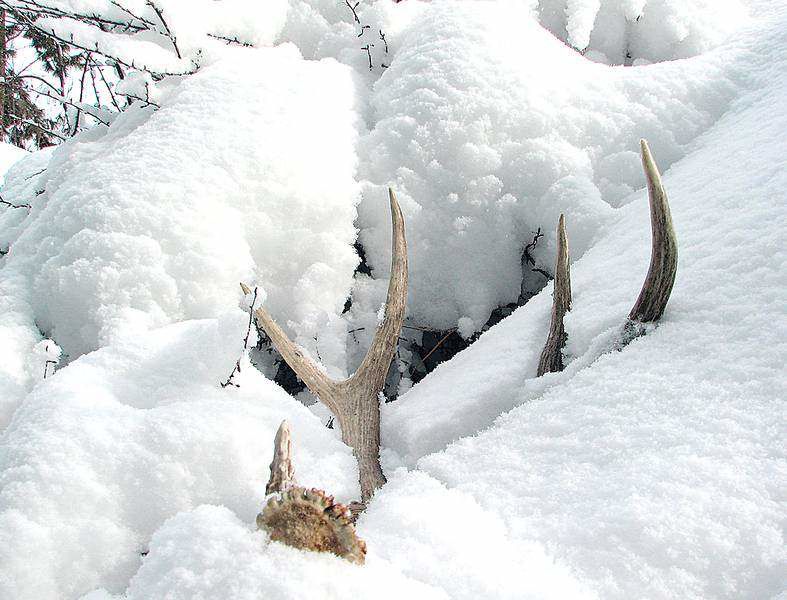Shed antlers provide scouting clues for deer and elk hunters
Published 4:00 am Thursday, January 31, 2008

- A four-point mule deer antler. Antler buyers and collectors pay top dollar for matched sets and antlers from mature bucks.
Maybe if I’d found the antler first, I’d have put my tag on Mr. Big. We jumped him at the bottom of a canyon where he’d bedded in the sage. He stotted through the brush for about 250 yards, then turned to get a look at us. He’d let us get too close and he wasn’t likely to make that mistake again.
His antlers were heavy, at least 34 inches wide, and carried their mass all the way to the four-point crowns on each side. He was one of the biggest bodied mule deer I’ve ever seen. And I never saw him again.
When the season opened, I made my play. I saw a lot of deer, but there was no sign of Mr. Big. I did find one of his antlers, a bleached-out shed. As far as I know, no other hunter found that buck either.
Mule deer, blacktail deer and whitetails drop their antlers between January and March. Elk usually drop their headgear between March and May. Their castoff crowns can provide scouting clues for hunters hoping to tie their tags on older age-class bucks and bulls.
Twenty years ago, the pursuit of antlers was practiced by a few. These days it has become a passion that, for some people, replaces the hunt. Antlers are made into lamps, chandeliers, chairs, tables and lots of other things. Like any commodity, the price fluctuates. But a brown, top-quality fresh, four-point chandelier-ready deer antler can bring $14 a pound, while a set of trophy-class antlers may bring thousands.
Some guys justify the cost of their ATVs with the money they bring home from the antler buyer.
A few years ago, I hunted sheds with my friends Brian Davis and Paul Carter. I found two that day, a dried-out three-point and an old, bleached-out four-point shed that had been stuck in the fork of a juniper. The trunk had grown around it in the intervening years to lock the bone in its grasp. I left that one there and sold the other to an antler buyer for 50 cents.
Last year, while hunting bear with Bryan Murphy in the Snake River Unit, I was showing off my new Alpen binoculars. While I had them up to my eyes we started talking about elk antlers. I saw something white lying on a bush about 200 yards away. It was a five-point elk shed. Bryan hiked over and picked it up. It was so desiccated and we were so far from the road, we decided to leave it. Good thing we’re not trying to justify ATV payments.
Several outfitters have cashed in on the craze and are offering guided shed hunts. No hassles with transporting guns and bows in airports, but you’d better bring a good backpack and be ready to pay excess baggage fees on the way home.
Several shed organizations have sprung up. One of the better organized groups is the Oregon Shed Hunters (www.oregonshedhunters.com), based in Central Oregon. They put on group hunts, offer contests and keep records. The North American Shed Hunters Club (www.shedantlers.org) lists news about auctions and how to connect with collectors. The site, www.shedantler.net, allows shed hunters to post pictures, stories and tips. A site dedicated to the training of antler dogs can be found at www.antlerdogs.com.
Steve Waller, the owner of Cabin Creek Kennels (www.cabincreekgundogs.com) in Oakland, Ore., has been training dogs since 1971. He has been training antler dogs for the last four or five years.
“Labs work very well because they’re a natural retriever,” Waller said. “When the ground is wet and there is more undergrowth, a lab might be the best choice because they hunt with their heads down. A good upland dog hunts with its head up and he’s going to smell a chukar; he’ll also smell an antler.
“They need to have a strong desire to retrieve, probably stronger than normal. In a lot of cases, that antler has been laying there for a year.”
Which means the dog may not be quite as excited about finding a dried piece of deer headgear as he might get about jumping a chukar or covey of quail.
“The key thing is they need to be force-fetch trained so that once they get the antler in their mouth, they’ll deliver it to hand,” Waller said.
On spring and summer scouting trips, using a dog to locate sheds can save a lot of time and help a hunter focus. One hunter who tagged a record-class Roosevelt elk with his recurve bow last year credited his success to his dog, who found the antlers first.
“No more than a handful of people are using antler dogs right now,” Waller said. “A lot of these guys are terribly secretive.”
With good reason. They’ve figured out that man’s best friend is not going to tell their buddies about the best hunting spots or beat them to the trophy when the season opens.






